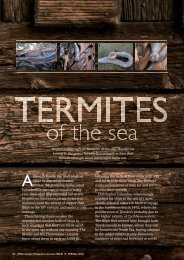Technical Insights: Method for mosquito repellent tests on candles
Technical Insights: Method for mosquito repellent tests on candles
Technical Insights: Method for mosquito repellent tests on candles
You also want an ePaper? Increase the reach of your titles
YUMPU automatically turns print PDFs into web optimized ePapers that Google loves.
<str<strong>on</strong>g>Technical</str<strong>on</strong>g> <str<strong>on</strong>g>Insights</str<strong>on</strong>g>:<br />
<str<strong>on</strong>g>Method</str<strong>on</strong>g> <str<strong>on</strong>g>for</str<strong>on</strong>g> <str<strong>on</strong>g>mosquito</str<strong>on</strong>g> <str<strong>on</strong>g>repellent</str<strong>on</strong>g> <str<strong>on</strong>g>tests</str<strong>on</strong>g> <strong>on</strong> <strong>candles</strong><br />
Poseid<strong>on</strong> Sciences<br />
Group<br />
122 East 42nd Street<br />
Suite 1700, New York, NY 10168<br />
USA<br />
jrmatias@poseid<strong>on</strong>sciences.com<br />
www.poseid<strong>on</strong>sciences.com<br />
Poseid<strong>on</strong> Sciences<br />
is a research and<br />
development company<br />
specializing in<br />
biological <str<strong>on</strong>g>tests</str<strong>on</strong>g> of<br />
materials and <str<strong>on</strong>g>for</str<strong>on</strong>g>mula<strong>on</strong>s<br />
in a wide<br />
range of products,<br />
including marine,<br />
cosmecs, pharmaceucals<br />
and related<br />
industries.<br />
There has been a proliferati<strong>on</strong> of <strong>candles</strong> with claims of <str<strong>on</strong>g>mosquito</str<strong>on</strong>g> protecti<strong>on</strong>. However, objective<br />
data <strong>on</strong> the per<str<strong>on</strong>g>for</str<strong>on</strong>g>mance of such products are often lacking. Human <str<strong>on</strong>g>tests</str<strong>on</strong>g> c<strong>on</strong>ducted<br />
during the biting period of <str<strong>on</strong>g>mosquito</str<strong>on</strong>g>es in an outdoor setting are the most objective method of<br />
testing candle <str<strong>on</strong>g>repellent</str<strong>on</strong>g> per<str<strong>on</strong>g>for</str<strong>on</strong>g>mance. But, when in the process of developing optimum <str<strong>on</strong>g>for</str<strong>on</strong>g>mulati<strong>on</strong>,<br />
human testing can be expensive and time c<strong>on</strong>suming. For this reas<strong>on</strong>, scientists at Poseid<strong>on</strong><br />
have developed a c<strong>on</strong>venient screening method to show the per<str<strong>on</strong>g>for</str<strong>on</strong>g>mance of experimental<br />
candle <str<strong>on</strong>g>for</str<strong>on</strong>g>mulati<strong>on</strong>s.<br />
This document describes procedures <str<strong>on</strong>g>for</str<strong>on</strong>g> the laboratory evaluati<strong>on</strong> of <strong>candles</strong> submitted to<br />
Poseid<strong>on</strong> Sciences (Poseid<strong>on</strong>) to evaluate the effects against C. quinquefasciatus. The test<br />
samples are typically prepared<br />
by the project sp<strong>on</strong>sor and<br />
submitted <str<strong>on</strong>g>for</str<strong>on</strong>g> evaluati<strong>on</strong> to<br />
Poseid<strong>on</strong>. All studies were<br />
c<strong>on</strong>ducted at the Poseid<strong>on</strong><br />
Sciences Insect C<strong>on</strong>trol Laboratory<br />
in Miagao, Iloilo<br />
(Philippines).<br />
The test system comprises<br />
an enclosed candle chamber<br />
attached by a screened wall<br />
to a 6 ft tunnel (1 ft wide, 4 ft<br />
high; covered with solid white<br />
cloth) through which the candle<br />
‘smoke’ is permitted to<br />
travel. The <str<strong>on</strong>g>mosquito</str<strong>on</strong>g>es (100+)<br />
as late stage pupae were introduced into the tunnel area in the evening prior to the start of the<br />
study <strong>on</strong> the following day at 10 AM. By morning, these pupae had emerged into adult <str<strong>on</strong>g>mosquito</str<strong>on</strong>g>es<br />
and fed <strong>on</strong> sugar soluti<strong>on</strong> and distribute throughout the tunnel. Not all the <str<strong>on</strong>g>mosquito</str<strong>on</strong>g>es<br />
emerge successfully so that there will be variability <strong>on</strong> the total number of <str<strong>on</strong>g>mosquito</str<strong>on</strong>g>es <strong>on</strong> each<br />
run. Each test comprises new <str<strong>on</strong>g>mosquito</str<strong>on</strong>g>es introduced to the tunnel. The numbers are normalized<br />
as percentage of the total <str<strong>on</strong>g>mosquito</str<strong>on</strong>g>es. Inside the tunnel are five pieces of 6 inch x 28 inch<br />
black cloth hanging from the top of the chamber at 1 ft. intervals. Mosquitoes prefer to perch <strong>on</strong><br />
darker surfaces, but do tend to fly from <strong>on</strong>e area to another.<br />
The candle is introduced into the chamber and lit <str<strong>on</strong>g>for</str<strong>on</strong>g> a total of 20 minutes and withdrawn.<br />
The time was sufficient to have the smoke permeate by passive movement though the tunnel<br />
and exit <strong>on</strong> the screened porti<strong>on</strong> at the end of the tunnel. If a <str<strong>on</strong>g>repellent</str<strong>on</strong>g> effect is observed, the<br />
<str<strong>on</strong>g>mosquito</str<strong>on</strong>g>es will move as far away from the candle chamber, preferentially perching <strong>on</strong> the ceiling<br />
walls and screen at the end of the tunnel. This behavior can occur in a matter of sec<strong>on</strong>ds.<br />
The number of <str<strong>on</strong>g>mosquito</str<strong>on</strong>g>es perched <strong>on</strong> the cloth and the walls of chamber are counted after the<br />
20 min exposure by opening a screened side of <strong>on</strong>e wall.
EXAMPLE OF TYPICAL<br />
EXPERIMENTAL RESULTS<br />
The data show the following trends:<br />
1. The <str<strong>on</strong>g>mosquito</str<strong>on</strong>g>es equally perched <strong>on</strong> cloth<br />
and walls. However, there were no dramatic<br />
differences between c<strong>on</strong>trol and experimental<br />
candle summarized as percentage perched according<br />
to z<strong>on</strong>es. The experimental candle uses<br />
low risk EPA listed compounds of marginal repellency<br />
effects.<br />
2. The smoke permeated through the tunnel as<br />
evidenced by the fragrance emerging from the<br />
end of screened tunnel c<strong>on</strong>firming that there was<br />
adequate movement of the smoke from the candle<br />
chamber to the end of the 6 ft tunnel. Mosquitoes<br />
remained <strong>on</strong> same locati<strong>on</strong>s and appeared<br />
not bothered by the <strong>candles</strong>.<br />
3. Preliminary <str<strong>on</strong>g>tests</str<strong>on</strong>g> were c<strong>on</strong>ducted in which<br />
exposure at 10, 20 and 30 minutes did not make<br />
any significant difference in the results (data not<br />
shown here)<br />
4. An additi<strong>on</strong>al test was c<strong>on</strong>ducted by inclusi<strong>on</strong><br />
of 5% DEET in candle wax and similarly<br />
exposed to the same test regimen.<br />
The data above shows that DEET also had marginal<br />
effect at the low c<strong>on</strong>centrati<strong>on</strong> used here.<br />
An additi<strong>on</strong>al reference test was also c<strong>on</strong>ducted<br />
to re-validate the test using Li<strong>on</strong> Tiger <str<strong>on</strong>g>mosquito</str<strong>on</strong>g><br />
coil (regular size, c<strong>on</strong>taining methofluthrin; see<br />
http://www.li<strong>on</strong>-tiger.com/products/<str<strong>on</strong>g>mosquito</str<strong>on</strong>g>_coils/index.html). The data show that <str<strong>on</strong>g>mosquito</str<strong>on</strong>g> coil drove the <str<strong>on</strong>g>mosquito</str<strong>on</strong>g> away<br />
from the dark cloth, with 100% of the <str<strong>on</strong>g>mosquito</str<strong>on</strong>g>es perched <strong>on</strong> the walls and mostly at the ceiling of the tunnel. The exposure<br />
was <strong>on</strong>ly <str<strong>on</strong>g>for</str<strong>on</strong>g> a period of 3 sec<strong>on</strong>ds and sufficient to exhibit extreme avoidance behavior by the <str<strong>on</strong>g>mosquito</str<strong>on</strong>g>es in the tunnel.














